
From Tangier to Alexandria 1325
The
Rihla Book 1
The
Maghreb, Egypt, Syria, and his First Hajj, 1325-26

From
Tangier to Alexandria 1325
Rihla
1, 1325
Tangier
1325
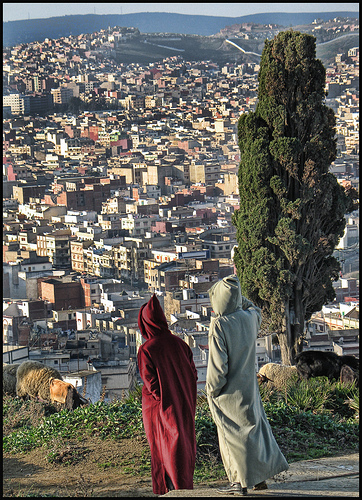
Tangier
Photo flickr.com
"I set out alone, finding no companion to cheer the way with friendly intercourse, and no party of travellers with whom to associate myself. Swayed by an overmastering impulse within me, and a long-cherished desire to visit those glorious sanctuaries of the Holy Cities, I resolved to quit all my friends and tear myself away from my home. As my parents were still alive, it weighed grievously upon me to part from them, and both they and I were afflicted with sorrow."
Rihla
1, 1325
Tlemcen 1325
"On reaching the city of Tilimsan [Tlemsen], whose sultan at that time was Abu Tashifin, I found there two ambassadors of the Sultan of Tunis, who left the city on the same day that I arrived. One of the brethren having advised me to accompany them, I consulted the will of God in this matter, and after a stay of three days in the city to procure all that I needed, I rode after them with all speed."
Rihla
1, 1325
Khemis-Milliana

Miliana
early in the morning
Photo mouhamed miliana Panoramio
"I overtook the Tunisian ambassadors at the town of Miliana, where we stayed ten days, as both ambassadors fell sick on account of the summer heats. When we set out again, one of them grew worse, and died after we had stopped for three nights by a stream four miles from Miliana. I left their party there and pursued my journey, with a company of merchants from Tunis."
Rihla
1, 1325
Algiers

Algiers,
Mosque Ketchaoua, 1096
Photo bachounda, Panoramio
"On reaching al-Jaza'ir [Algiers] we halted outside the town for a few days, until the former party rejoined us, when we went on together through the Mitija [the fertile plain behind Algiers] to the mountain of Oaks [Jurjura] and so reached Bijaya [Bougiel]. "
Rihla
1, 1325
Bejaia

Bejaia
coastline.
Photo: Mouloud
Benyahia, elmain.free.fr
"The
commander of Bijaya at this time was the chamberlain Ibn Sayyid
an-Nas. Now one of the Tunisian merchants of our party had died
leaving three thousand dinars of gold, which he had entrusted to a
certain man of Algiers to deliver to his heirs at Tunis. Ibn Sayyid
an-Nas came to hear of this and forcibly seized the money. This was
the first instance I witnessed of the tyranny of the agents of the
Tunisian government.
At Bijaya I fell ill of a fever, and one of
my friends advised me to stay there till I recovered. But I refused,
saying, "If God decrees my death, it shall be on the road with
my face set toward Mecca." "If that is your resolve,"
he replied, "sell your ass and your heavy baggage, and I shall
lend you what you require. In this way you will travel light, for we
must make haste on our journey, for fear of meeting roving Arabs on
the way." I followed his advice and he did as he had
promised--may God reward him!"
Rihla
1, 1325
Qusantînah-Constantine
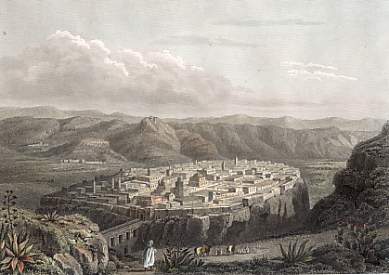
Constantine
from an old print
Photo antique-prints.de
"On
reaching Qusantinah [Constantine] we camped outside the town, but a
heavy rain forced us to leave our tents during the night and take
refuge in some houses there.
Next day the governor of the city
came to meet us. Seeing my clothes all soiled by the rain he gave
orders that they should be washed at his house, and in place of my
old worn headcloth sent me a headcloth of fine Syrian cloth, in one
of the ends of which he had tied two gold dinars. This was the first
alms I received on my journey."
Rihla
1, 1325
Bona-Anaba

Anaba
Photo from soleildafrique.com
"From
Qusantinah we reached Bona [Bone] where, after staying in the town
for several days, we left the merchants of our party on account of
the dangers of the road, while we pursued our journey with the utmost
speed.
I was again attacked by fever, so I tied myself in the
saddle with a turban-cloth in case I should fall by reason of my
weakness. So great was my fear that I could not dismount until we
arrived at Tunis."
Rihla
1, 1325
Tunis

The
City of Tunis
Photo from another contemporary biography of Ibn
Khaldun
Caroline
Stone, Saudi-Aramco
"At last we came to the town of Tunis.... Townsfolk came forward on all sides with greetings and questions to one another. But not a soul said a word of greeting to me, since there was none of them that I knew. I felt so sad at heart on account of my loneliness that I could not restrain the tears that started to my eyes, and wept bitterly. But one of the pilgrims, realizing the cause of my distress, came up to me with a greeting and friendly welcome, and continued to comfort me with friendly talk until I entered the city, where I lodged in the College of the Booksellers."
Rihla
1, 1325
Susah-Sousse
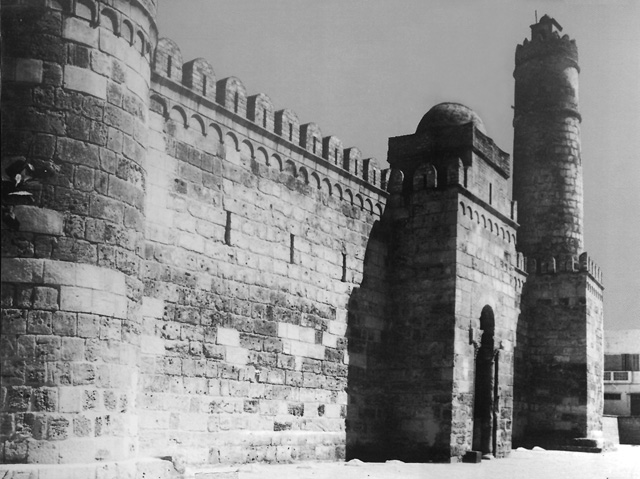
The
Fort. Wall enclosure and gate
Photo from thais.com
"Some time later the pilgrim caravan for the Hijaz was formed, and they nominated me as their qadi [judge]. We left Tunis early in November [1325], following the coast road through Susa Sfax, and Qabis, where we stayed for ten days on account of incessant rains. Thence we set out for Tripoli, accompanied for several stages by a hundred or more horsemen as well as a detachment of archers, out of respect for whom the Arabs [brigands] kept their distance."
Rihla
1, 1325
Sfax
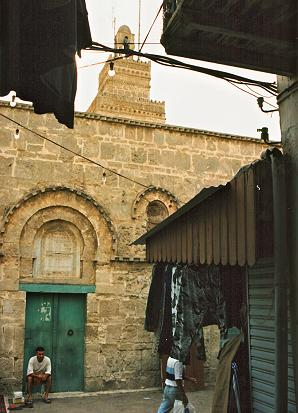
Entry
to the Great Mosque at Sfax
Photo from i-cias.com/tunisia
Rihla
1, 1325
Gabes

The
vanguard of the caravan entering the oasis of Gabes.
Photo:
travelinstyle
Rihla
1, 1325
Tripoli

The
Happy Pilgrim with his Bride.
"I had made a contract of marriage at Sfax with the daughter of one of the syndics at Tunis, and at Tripoli she was conducted to me, but I became involved in a dispute with her father, which necessitated my separation from her. I then married the daughter of a student from Fez, and when she was conducted to me at Tripoli I detained the caravan for a day by entertaining them at a wedding party."
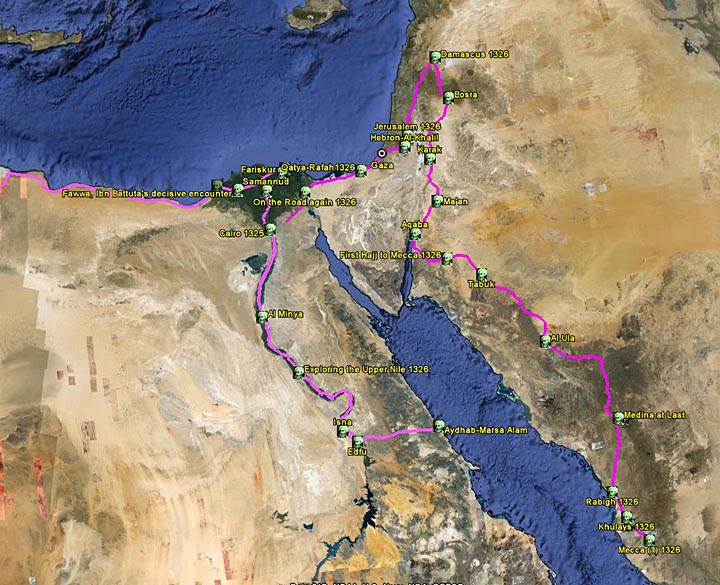
Alexandria
to Damascus and on to Mecca
Rihla
1, 1325
Alexandria
and Burhan al-Din

The
Lighthouse of Alexandria.
Photo: dialforblog.com
"On
April 5th (1326) we reached Alexandria. It is a beautiful city,
well-built and fortified with four gates and a magnificent port.
Among all the ports in the world I have seen none to equal it except
Kawlam [Quilon] and Calicut in India, the port of the infidels
[Genoese] at Sudaq [Sudak, in the Crimea] in the land of the Turks,
and the port of Zaytun [Xiamen] in China, all of which will be
described later.
I went to see the lighthouse on this occasion
and found one of its faces in ruins. It is a very high square
building, and its door is above the level of the earth. Opposite the
door, and of the same height, is a building from which there is a
plank bridge to the door; if this is removed there is no means of
entrance.
It is situated on a high mound and lies three miles
from the city on a long tongue of land which juts out into the sea
from close by the city wall, so that the lighthouse cannot be reached
by land except from the city.
On my return to the West in the
year 750 [1349] I visited the lighthouse again, and found that it had
fallen into so ruinous a condition that it was not possible to enter
it or climb up to the door.
I met the pious ascetic Burhan
al-Din, whose hospitality I enjoyed for three days. One day he said
to me, "I see that you are fond of traveling through foreign
lands." I replied, "Yes, I am" (though as yet I had no
thoughts of going to such distant lands as India or China). Then he
said, "You must certainly visit my brother Farid al-Din in
India, and my brother Rukn al-Din in Sind [Pakistan], and my brother
Burhan al-Din in China. When you find them, give them greetings from
me." I was amazed at his prediction, but the idea of going to
these countries once cast into my mind, my journey never ceased until
I had met these three and conveyed his greeting to them."
After this fateful revelation Battuta faithfully went to extraordianry troubles and visited all three brothers of Burhan al-Din.
Rihla
1, 1325
Fawwa, Ibn Battuta's
decisive encounter

The
Bird Simurgh fighting with Iskandiyar (Alexander), Firdausi's
Shah-name, Shiraz 1330
Photo ee.bilkent.edu
In a small village near Alexandria Ibn Battuta had an encounter which would change his life:
"During
my stay at Alexandria I had heard of the pious Shaykh al-Murshidi,
who bestowed gifts miraculously created at his desire. He lived in
solitary retreat in a cell at Fawwa in the country where he was
visited by princes and ministers.
I set out from Alexandria
to seek this shaykh and passing through Damanhur came to Fawwa, a
beautiful township close by separated from it by a canal, lies the
shaykh's cell.
That night, while I was sleeping on the roof
of the cell, I dreamed that I was on the wing of a great bird which
was flying me toward Makkah, then to Yemen, then eastward, and
thereafter going south, then flying far eastward, and finally landing
in a dark, green country, where it left me.... Next morning, the
Shaykh interpreted it to me, "You will make the Hajj and visit
the Tomb [of the Prophet], and you will travel through Yemen, Iraq,
the country of the Turks, and India. You will stay there a long time
and meet my brother Dilshad the Indian, who will rescue you from a
danger into which you will fall." Never since I departed from
him have I received aught but good fortune."
Rihla
1, 1325
Cairo 1325

View
of Cairo 1901
Photo: cnx.org
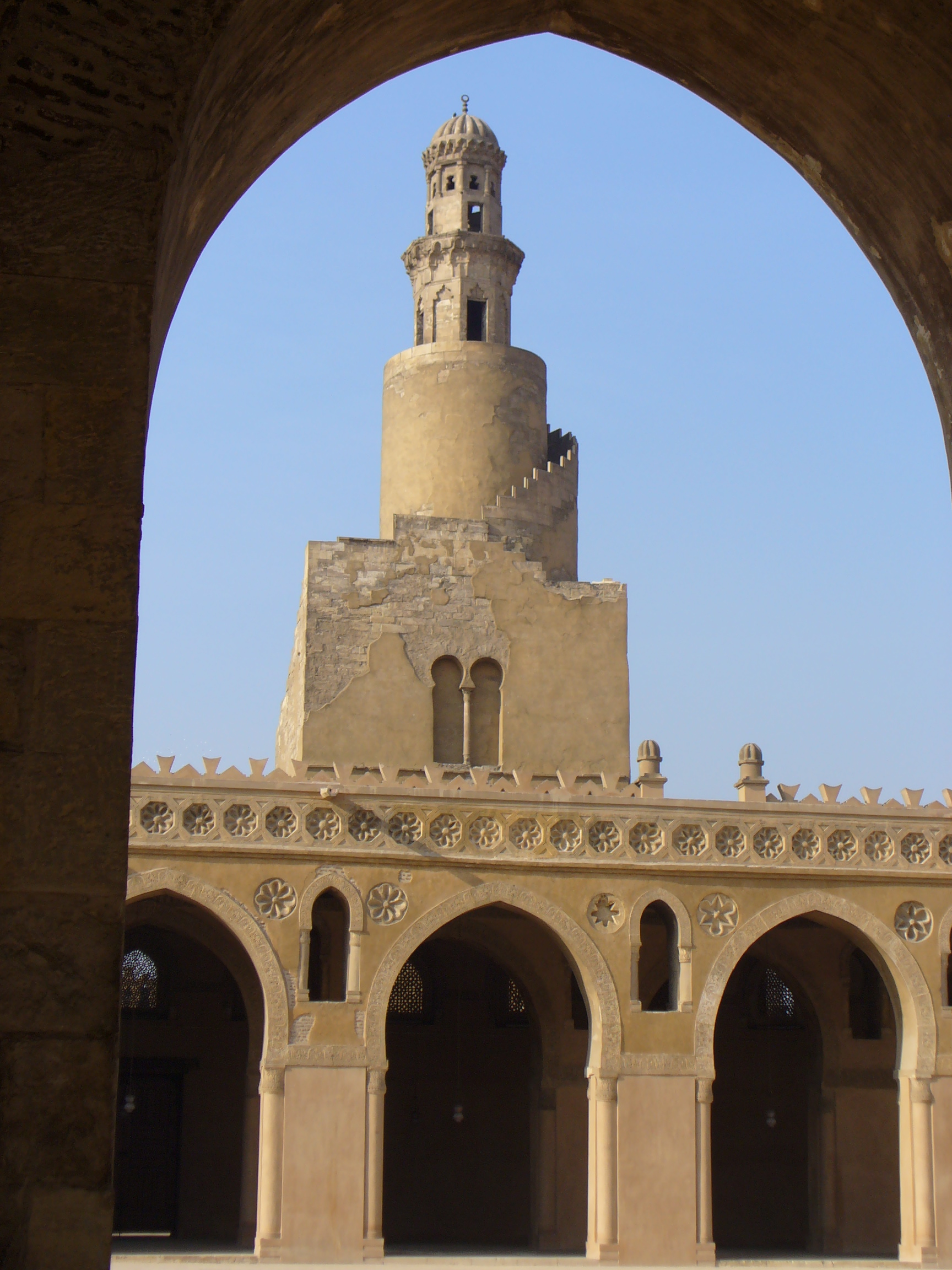
The
spiral minaret of the Ibn-Tulun Mosque (870-879) is, obviously a
Cairene copy of Samarra's al-Muttawikil (847-892), Ibn Tulun's home
town
Photo Sacred
Destinations
Overwhelmed
by the Cairene metropolis Battuta writes:
"It
is said that in Cairo there are 12,000 water carriers who transport
water on camels, 30,000 hirers of mules and donkeys, and on the Nile
36,000 boats belonging to the sultan and his subjects, which sail
upstream to Upper Egypt and downstream to Alexandria and Damietta
laden with goods and profitable merchandise of all kinds. On the
banks of the Nile opposite Cairo is a place known as The Garden,
which is a pleasure park and promenade containing many beautiful
gardens, for the people of Cairo are given to pleasure and
amusements.... The madrasas cannot be counted for multitude.... The
Maristan hospital has no description adequate to its beauties...."
Rihla
1, 1325
Damietta
1325

The
fleet of the Seventh Crusade under unlucky, romantic King Louis IX of
France before Damietta (1250).
Photo from Wikimedia
"We
rode from here to Damietta through a number of towns, in each of
which we visited the principal men of religion. Damietta lies on the
bank of the Nile. The present town is of recent construction; the old
city was destroyed by the Franks in the time of al Malik as al-Salih
(1250).
From here I went to Samannud, whence I journeyed
upstream to Cairo.
Rihla
1, 1325
Fariskur

In
1250 the Frankish crusaders got as far as Farikskur where the
Egyptian forces led by Turanshah defeated them and captured King
Louis IX of France who would later become "Saint Louis".
Image Wikipedia
"Fariskur is a town on the bank of the Nile. Here I was overtaken by a horseman who had been sent after me by the governor of Damietta. He handed me a number of coins saying to me "The Governor asked for you, and on being informed about you, he sent you this gift"--may God reward him!"
Rihla
1, 1325
Samannud
"I
continued to Samannud, from where I journeyed upstream to Cairo
between a continuous succession of towns and villages. The traveller
on the Nile need take no provision with him because whenever he
desires to descend on the bank he may do so, for ablutions, prayers,
provisioning, or any other purpose. There is an uninterrupted chain
of bazaars from Alexandria to Cairo, and from Cairo to Assuan [Aswan]
in Upper Egypt.."
Rihla
1, 1325
Exploring the Upper Nile
1326

Dhows
on the Nile
Photo: Wikipedia
"From
Cairo I travelled into Upper Egypt, with the intention of crossing to
Jedda and the Hijaz (Hajj) to Mecca.
The Egyptian Nile
surpasses all rivers of the earth in sweetness of taste, length of
course, and utility. No other river in the world can show such a
continuous series of towns and villages along its banks, or a basin
so intensely cultivated. Its course is from South to North, contrary
to all the other great rivers.
One extraordinary thing about
it is that it begins to rise in the extreme hot weather at the time
when rivers generally diminish and dry up, and begins to subside just
when rivers begin to increase and overflow. The river Indus resembles
it in this feature."
Rihla
1 1325
Al Minya

Town
on the Nile.
Photo: Hannah Scharlau, 2007
My
way lead through a number of towns and villages to Munyat Ibn Khasib
[Minya], a large town which is built on the bank of the Nile, and
most emphatically excels all the other towns of Upper Egypt.
I
went on through Manfalut, Asyut, Ikhmin, where there is a berba with
sculptures and inscriptions which no one can now read-another of
these berbas there was pulled down and its stones used to build a
madrasa--Qina, Qus, where the governor of Upper Egypt resides, Luxor,
a pretty little town containing the tomb of the pious ascetic
Abu'l-Hajjaj, to Esna (Isna).
Rihla
1, 1325
Isna
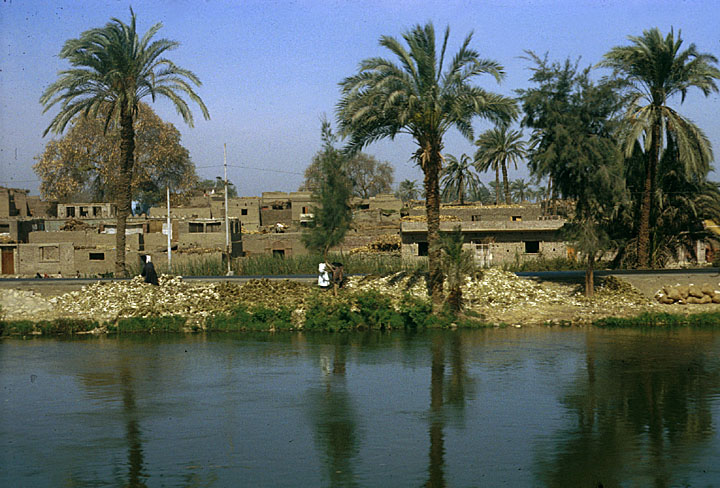
Village
on the Upper Nile.
Photo: exploringafrica.msu.edu
"From Esna we traveled a day and a night through desert country to Edfu."
Rihla
1, 1325
Edfu
"In
Edfu we crossed the Nile and, hiring camels, journeyed with a party
of Arabs through a desert, totally devoid of settlements but quite
safe for travelling. One of our halts was at Humaythira, a place
infested with hyenas. All night long we kept driving them away, and
indeed one got at my baggage, tore open one of the sacks, pulled out
a bag of dates, and made off with it. We found the bag next morning,
torn to pieces and with most of the contents eaten."
Rihla
1, 1325
Aydhab-Marsa
Alam

The
Red Sea at Aydhab
Old etching from templaricavalieri.it
"After
fifteen days' travelling we reached the town of Aydhab, a large town,
well supplied with milk and fish; dates and grain are imported from
Upper Egypt.
Its inhabitants are Bejas. These people are
black-skinned; they wrap themselves in yellow blankets and tie
headbands about a fingerbreadth wide round their heads. They do not
give their daughters any share in their inheritance. They live on
camels milk and they ride on Meharis [dromedaries].
One-third
of the city belongs to the Sultan of Egypt and two-thirds to the King
of the Bejas, who is called al-Hudrubi.
On reaching Aydhab we
found that al-Hudrubi was engaged in warfare with the Turks [i.e. the
troops of the Sultan of Egypt], that he had sunk their ships and that
the Turks had fled before him. It was impossible for us to attempt to
cross the Red Sea, so we sold the provisions that we had made ready
for it, and returned to Qus with the Arabs from whom we had hired the
camels.
Rihla
1, 1326
On the Road again 1326
"I reached Cairo, where I stayed only one night, and immediately set out for Syria. This was in the middle of July, 1326. My route lay through Bilbays and as-Salihiya, after which we entered the sands and halted at a number of stations. At each of these there was a hostelry which they call a khan, where travellers alight with their beasts. Each khan has a water wheel supplying a fountain and a shop at which the traveller buys what he requires for himself and his beasts"
Rihla
1, 1326
Qatya-Rafah

The
border crossing at Rafah today
Photo MidEastEye,
Panoramio
"At
the station of Qatya [Rafah] customs-dues are collected from the
merchants, and their goods and baggage are thoroughly examined and
searched.
There are offices here, with officers, clerks, and
notaries, and the daily revenue is a thousand gold dinars. No one is
allowed to pass into Syria without a passport from Egypt, nor into
Egypt without a passport from Syria, for the protection of the
property of the subjects and as a measure of precaution against spies
[sic!] from Iraq.
The responsibility of guarding this road has
been entrusted to the Badawin [Bedouin]. At nightfall they smooth
down the sand so that no track is left on it, then in the morning the
governor comes and looks at the sand. If he finds any track on it he
commands the Arabs to bring the person who made it, and they set out
in pursuit and never fail to catch him. He is then brought to the
governor, who punishes him as he sees fit.
The governor at
the time of my passage treated me as a guest and showed me great
kindness, and allowed all those who were with me to pass. From here
we went on to Gaza, which is the first city of Syria on the side next
the Egyptian frontier."
Rihla
1, 1326
Hebron-Al-Khalil

Hebron,
where the Patriarchs and their wives are buried.
Etching Atlas
Tours
"From
Gaza I travelled to the city of Abraham [Hebron], the mosque of which
is of elegant, but substantial construction, imposing and lofty, and
built of squared stones. It is said that Solomon commanded a jinn to
build it. Inside it is the sacred cave containing the graves of
Abraham, Isaac, and Jacob, opposite which are three graves, which are
those of their wives.
I questioned the imam, a man of great
piety and learning, on the authenticity of these graves, and he
replied: "All the scholars whom I have met hold these graves to
be the very graves of Abraham, Isaac, Jacob and their wives. No one
questions this except introducers of false doctrines; it is a
tradition which has passed from father to son for generations and
admits of no doubt."
This mosque contains also the grave
of Joseph, and somewhat to the east of it lies the tomb of Lot, which
is surmounted by an elegant building. In the neighbourhood is Lot's
lake [the Dead Sea], which is brackish and is said to cover the site
of the settlements of Lot's people."

Hebron,
the Maarat Hamachpelah, the tomb of the Jewish Patriarchs metioned by
Battuta and visible in the above veduta
Photo: Holyexposures.com
Rihla
1, 1326
Bethlehem

Bethlehem.
on the left is the Church of the Holy Sepulchure.
Etching from
Trevelhistory.org
"On the way from Hebron to Jerusalem, I visited Bethlehem, the birthplace of Jesus. The site is covered by a large building; the Christians regard it with intense veneration and hospitably entertain all who alight at it."
Rihla
1, 1326
Jerusalem

The
Siege and Destruction of Jerusalem by the Romans under Titus, A.D.
70. painting by David Roberts.
Image preteristarchive
and Wikipedia

Jerusalem
from the Mount of Olives, a cemetery in the foreground.
Photo
from Brit.Government
Collection
"The
sacred mosque is an open court and unroofed, except for the mosque
al-Aqsa, which has a roof of most excellent workmanship.
The
Dome of the Rock [al-Aqsa] is a building of extraordinary beauty,
solidity, elegance, and singularity of shape. It stands on an
elevation in the centre of the mosque and is reached by a flight of
marble steps.
Both outside and inside the decoration is so
magnificent and the workmanship so surpassing as to defy description.
The greater part is covered with gold so that the eyes of one who
gazes on its beauties are dazzled by its brilliance, now glowing like
a mass of light, now flashing like lightning. In the centre of the
Dome is the blessed rock from which the Prophet ascended to heaven, a
great rock projecting about a man's height, and underneath it there
is a cave the size of a small room, also of a man's height, with
steps leading down to it. Encircling the rock are two railings of
excellent workmanship, the one nearer the rock being artistically
constructed in iron and the other of wood.
Among the
grace-bestowing sanctuaries of Jerusalem is a building, situated on
the farther side of the valley called the valley of Jahannam
[Gehenna] to the east of the town, on a high hill. This building is
said to mark the place whence Jesus ascended to heaven. In the bottom
of the same valley is a church venerated by the Christians, who say
that it contains the grave of Mary.
In the same place there
is another church which the Christians venerate and to which they
come on pilgrimage. This is the church of which they are falsely
persuaded to believe that it contains the grave of Jesus [Church of
the Holy Sepulcher]. All who come on pilgrimage to visit it pay a
stipulated tax to the Muslims, and suffer very unwillingly various
humiliations."
Rihla
1, 1326 1330
Damascus
1326
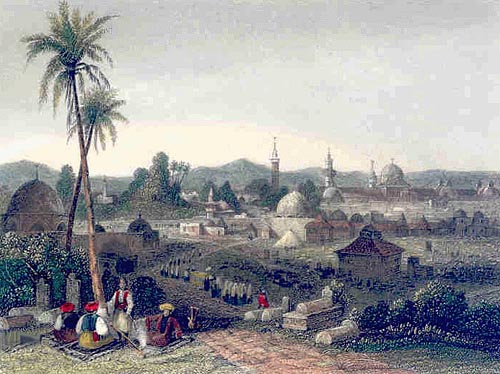
View
of Damascus

Market
in the Old City

Inside
the Umayyad Mosque (colored etching by W. H. Bartlett)
Old
etchings from templaricavalieri.it
Battuta writes a long
discourse on the history of the Umayyad Mosque, once a Christian
church sacred to St John the Baptist, it was gradually transformed
into a mosque.
"The Friday Mosque,
known as the Umayyad Mosque, is the most magnificent in the world,
the finest in construction, and the noblest in beauty, grace, and
perfection.... The site of the mosque was a [Greek Orthodox] church.
When the Muslims captured Damascus, one of their commanders entered
from one side by the sword and reached as far as the middle of the
church. The other entered peaceably from the eastern side and reached
the middle also. So the Muslims made the half of the church which
they had entered by force into a mosque, and the half which they had
entered by peaceful agreement remained a church."
In
Damascus Ibn Battuta also describes the waqfs, Islamic
institutions operated by pious endowments:
"The
variety and expenditure of the religious eitdowments of Damascus are
beyond computation. There are endowments for the aid of persons who
cannot undertake the Hajj [such as the aged and the physically
disabled], out of which are paid the expenses of those who go in
their stead. There are endowments to dower poor women for marriage.
There are others to free prisoners [of war]. There are endowments in
aid of travelers, out of the revenues of which they are given food,
clothing, and the expenses of conveyance to their countries. There
are civic endowments for the improvement and paving of the streets,
because all the lanes in Damascus have sidewalks on either side, on
which foot passengers walk, while those who ride the roadway use the
center.
One day I passed a young servant who had dropped a
Chinese porcelain dish, which was broken to bits. A number of people
collected around him and suggested, "Gather up the pieces and
take them to the custodian of the endowment for utensils." He
did so, and when the endowment custodian saw the broken pieces he
gave the boy money to buy a new plate. This benefaction is indeed a
mender of hearts."
Rihla
1 , 1326
First Hajj to Mecca 1326

Pilgrims
Caravan on their way to Mecca from the Persian “Maqqamat”
Photo
easyart.com
"When the new moon of the month Shawwal appeared in the same year [1st September 1326], the Hijaz caravan left Damascus and I set off along with it."
Rihla
1 , 1326
Bosra

Camel
caravan, 6th cent AD Roman mosaic in Bosra
Photo senna3,
Panoramio

The
Hadjj Ralroad at Bosra Station
Photo Hartmann,
Nabareaea.net
"At Bosra the caravans usually halt for four days so that any who have been detained at Damascus by business affairs may make up on them. Thence they go to the Pool of Ziza, where they stop for a day, and then through al-Lajjun to the Castle of Karak."
In
1908 the Ottomans built a railroad from Damascus to Medina. The
German enineers simply followed a caravan. - Unfortunately Battuta
did not always follow that route.
The railroad became famous
during WW I when Lawrence of Arabia nearly closed the strategic
connection by repeatedly blowing up the tracks.The railroad was never
revived but it it still works in Syria. A Mekka for railroad buffs. -
Nowadays the Hadjji fly, 200 people to an Airbus.
Rihla
1 , 1326
Karak-”Krak
des Chevaliers”

Karak
Crusaders Castle
Photo jorgetutor.com
"Karak,
which is also called "The Castle of the Raven," is one of
the most marvellous, impregnable, and celebrated of fortresses. It is
surrounded on all sides by the river-bed, and has but one gate, the
entrance to which is hewn in the living rock, as also is the approach
to its vestibule.
This fortress is used by kings as a place of
refuge in times of calamity, as the sultan an-Nasir did when his
mamluke Salar seized the supreme authority.
The caravan stopped
for four days at a place called ath-Thaniya outside Karak, where
preparations were made for entering the desert."
Rihla
1 , 1326
Ma'an

The
oasis of Ma'an
Photo wallpaper.com
"Thence we journeyed to Ma'an, which is the last town in Syria" (now Jordan)
Rihla
1 , 1326
'Aqabat as-Sawan-Aqaba
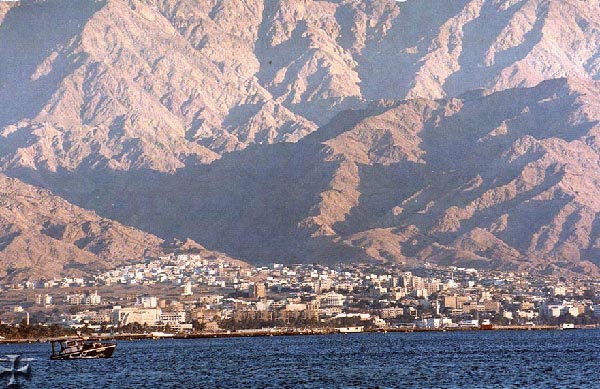
Aqaba
from the Golf
Photo templaricavalieri.it
"At 'Aqabat as-Sawan we entered the desert, of which the saying goes: He who enters it is lost, and he who leaves it is born."
Rihla
1 , 1326
Tabuk

Caravan
passing a water reservoir near Tabuk
Photo
green-birds.blogspot.com
"The
great caravan halts at Tabuk for four days to rest and to water the
camels and lay in water for the terrible desert between Tabuk and
al-Ula.
The custom of the watercarriers is to camp beside the
spring, and they have tanks made of buffalo hides, like great
cisterns, from which they water the camels and fill the waterskins.
Each amir or person of rank has a special tank for the needs of his
own camels and personnel; the other people make private agreements
with the watercarriers to water their camels and fill their
waterskins for a fixed sum of money.
From Tabuk the caravan
travels with great speed night and day, for fear of this desert.
Halfway through is the valley of al-Ukhaydir, which might well be the
valley of Hell (may God preserve us from it). One year the pilgrims
suffered terribly here from the samoom-wind; the water-supplies dried
up and the price of a single drink rose to a thousand dinars, but
both seller and buyer perished. Their story is written on a rock in
the valley.
Rihla
1 , 1326
Al Ula

Old
Al-Ula
Photo Mike
- Traveltrails, Panoramio
"Al-Ula
is a large and pleasant village with palm-gardens and water-springs.
The pilgrims halt there four days to provision themselves and wash
their clothes. They leave behind them here any surplus of provisions
they may have, taking with them nothing but what is strictly
necessary. The people of the village are very trustworthy.
The
Christian merchants of Syria may come as far as this and no further,
and they trade in provisions and other goods with the pilgrims here.
On the third(300 km?) day after leaving al-Ula the caravan halts in
the outskirts of the holy city of Medina.
Rihla
1 , 1326
Medina at Last

Medina
at last
Photo Shaykh
Hassan Cisse, tijani.org
At Dhu al-Hulaifa, just outside Madina, the pilgrims changed from their caravan clothes into the ihram, the two-piece white garment which symbolically consecrated their entry into the Holy City of Makkah. Once in the ihram, the Muslim's behavior was expected to be a model of piety, and the spiritual aura of Mecca reinforced that expectation.
"I entered the pilgrim state under obligation to carry out the rites of the Greater Pilgrimage...and [in my enthusiasm] I did not cease crying, "Labbaik, Allahumma" ["At Thy service, O God!"] through every valley and hill and rise and descent until I came to the Pass of 'Ali (upon him be peace), where I halted for the night."
Rihla
1 , 1326
Medina

Arrival
at Medina, Zilhaj al-Haraam 1427
Photo by Shaikh Taha Raja 2007
from akhabar.mumeen.org
Ibn Battuta's account
of Madinah fills 12 pages. Much of it is a detailed history and
description of the Prophet's Mosque and other sites; the rest
consists of anecdotes he heard from those he met.
"Our
stay in Madinah the Illustrious on this journey lasted four days. We
spent each night in the Holy Mosque, where everyone engaged in pious
exercises. Some formed circles in the court and lit a quantity of
candles. Volumes of the Holy Qur'an were placed on book-rests in
their midst. Some were reciting from it; some were intoning hymns of
praise to God; others were contemplating the Immaculate Tomb [of
Muhammad]; while on every side were singers chanting the eulogy of
the Apostle {Muhammad], may God bless him and give him peace."
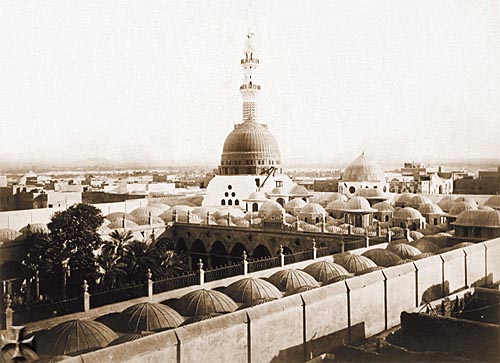
Old
Photo of the Prophet's mosque in Medina
from templaricavalieri.it
The
Mosque of the Prophet was built in 622 by the Muslim community after
they reached the city of Yathrib, which would later be called
al-Madina al-Muanwara. The mosque was situated next to the Prophet's
house, and it consisted of a square enclosure of thirty by
thirty-five meters, built with palm trunks and mud walls.

The
mosque of the humble Prophet today
Photo and text from
Archnet.org
After the death of the Prophet, the mosque was enlarged to twice its size. In 707, by Umayyad Caliph al-Walid (705-715). Mamluk Sultans built the dome over the Prophet's house and tomb and built and rebuilt the four minarets. The Ottomans (1517-1917) added and reconstucted the mosque until in the 20th cent the entire complex was remodeled and enlarged.
Rihla
1 , 1326
Rabigh 1326

Rabigh
used to be famous for its camels - it is now a ghastly oil terminal –
barely
visible
in the background - with a single hotel for the Aramco people.
Photo
James Scott Panoramio
"Our way led thence through a frightful desert called the Vale of Bazwa for three days to the valley of Rabigh, where the rainwater forms pools which lie stagnant for a long time. From this point the pilgrims put on the pilgrim garment. I too divested myself of my tailored clothes, bathed, and putting on the pilgrim's garment I prayed and dedicated myself to the pilgrimage."
Rihla
1 , 1326
Khulays 1326

Desert
Oasis near Khulays
"Three days after leaving Rabigh we reached the pool of Khulays, which lies in a plain and has many palm-gardens."
Rihla
1 , 1326
Usfan 1326
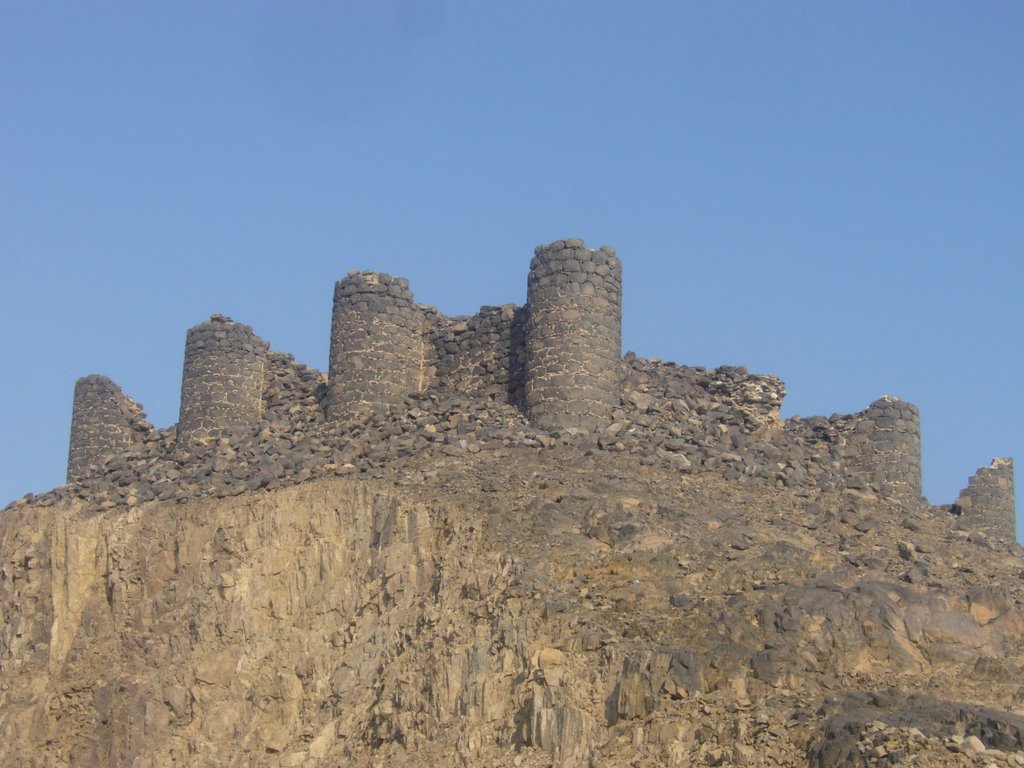
The
Ottoman
fortress at Usfan
Photo M.
Aziz, Panoramio
Thence
we travelled through 'Usfan to the Bottom of Marr, a fertile valley
with numerous palms and a spring supplying a stream from which the
district is irrigated. From this valley fruit and vegetables are
transported to Mecca.
We set out at night from this blessed
valley, with hearts full of joy at reaching the goal of our hopes,
and in the morning arrived at the City of Surety, Mecca (may God
ennoble her !), where we immediately entered the holy sanctuary and
began the rites of pilgrimage.
Rihla
1, 1326
Mecca (1) 1326

Mecca

The
Kaaba
Old etchings from templaricavalieri.it
The
Meccans are very elegant and clean in their dress, and most of them
wear white garments, which you always see fresh and snowy. They use a
great deal of perfume and kohl and make free use of toothpicks of
green arak-wood.
The Meccan women are extraordinarily
beautiful and very pious and modest. They too make great use of
perfumes to such a degree that they will spend the night hungry in
order to buy perfumes with the price of their food. They visit the
mosque every Thursday night, wearing their finest apparel; and the
whole sanctuary is saturated with the smell of their perfume. When
one of these women goes away the odor of the perfume clings to the
place after she has gone.
Rihla
1 , 1326
Return from Mecca 1326
On
the 17th of November 1326 I left Mecca with the commander of the
'Iraq caravan, who hired for me at his own expense half of a
camel-litter as far as Baghdad, and took me under his protection.
After the farewell ceremony of circumambulation [of the
Ka'ba] we moved out to the Bottom of Marr with an innumerable host of
pilgrims from 'Iraq, Khurasan, Fars and other eastern lands, so many
that the earth surged with them like the sea and their march
resembled the movement of a high-piled cloud. Any person who left the
caravan for a moment and had no mark to guide him to his place could
not find it again because of the multitude of people. With this
caravan there were many draught-camels for supplying the poorer
pilgrims with water, and other camels to carry the provisions issued
as alms and the medicines, potions, and sugar required for any who
fell ill. Whenever the caravan halted food was cooked in great brass
cauldrons, and from these the needs of the poorer pilgrims and those
who had no provisions were supplied.
From
Mecca Battuta returned to Baghdad with the 'Iraqi caravan. The
details are sketchy (at least in my translation
of the Rihla). Before reaching Baghdad he elopes to Basra and a
circle tour of Persia (Isfahan and Shiraz)
When Battuta left
Tangier his only purpose had been to reach the Holy City....
But when he set off for Baghdad from Mecca with the Iraqi pilgrims,
it becomes apparen that he was no longer traveling to fulfill only a
religious mission or even to reach a particular destination. He was
going back to Iraq simply for the adventure of it.